2 Nights in Heraklion – Airbnb at Melinas Merkouri 34, Iraklio
Crete is the largest and most populous of the Greek Islands with Heraklion as its capitol. A melting pot of cultures from Europe, Asia, and Africa, Crete is where the first European civilization – the Minoan – thrived. Minoan remains and sites are found at Knossos, Phaestus, and numerous other locations throughout the island.
We found that the fastest and most convenient way of travelling from Fira, Santorini to Heraklion, Crete is by ferry. The high speed boat left Fira at 4:15pm and reached Heraklion by 6:30pm. We took a taxi from the port to our Airbnb. The sites we were planning to visit around Heraklion were all within walking distance from our Airbnb except the Palace of Knossos. On the day we landed in Heraklion, we walked down to the city center and found restaurant that had a fair amount of vegetarian options in their menu and enjoyed a relaxed dinner.
- Morosini Fountain
- Loggia (Town Hall)
- The Palace of Knossos
- Harbor in the old town
- Koules Fortres
- Heraklion Archaeological Museum
- Cathedral of St. Minas
- Agios Titos Church
- Venetian walls surrounding Heraklion
Morosini Fountain – At the city center is the Morosini Fountain or the Lion Fountain, surrounded by trees and restaurants. It was built around 1628, during the Venetian rule of Crete. The Morosini Fountain played an important role in providing drinking water to the citizens of Heraklion. It was originally connected to a 14-kilometer aqueduct and brought water to the city from the slopes of Mt. Juktas.

Loggia (Town Hall) – This impressive Venetian Loggia stands in the heart of the city, near the Morosini Fountain. It is considered one of the most elegant Venetian constructions on the island, housing the Town Hall of Heraklion. Loggias were a typical feature of Venetian towns, constituting a place where Venetian noblemen gathered and discussed the local economic and political issues. At the same time, they also hosted a variety of social events and served as recreational clubs for the nobles. The Loggia that survives to this day was built in 1628 by the Venetian governor Francesco Morozini, who was also responsible for many other public works.


The Palace of Knossos – 15€/person entrance tkt – We took a taxi to the palace as it was quite far from our Airbnb. If you want to avoid cruise ship and tour bus crowd, be there by 8am when the palace doors open. Cruise ship and tour bus crowd start pouring in after 9:30am. You can download audio guide onto your phone at the entrance, which is a good idea as hiring a guide is expensive. Also, plan on spending about 2 hours here, even if you are not interested in history.
Knossos is considered by many to be the oldest city in Europe and is dominated by the palace of Minos. Like other Minoan palaces, this building served as a combination religious and administrative center rather than a royal residence. The earliest parts of the palace were built around 1900 BC and was continually renovated and expanded over the next five centuries until its final destruction around 1350 BC. The site was first excavated in 1877. In 1900, more extensive excavations undertaken by British archaeologist Arthur Evans, unearthed most of the palace as well as many now-famous artifacts which are displayed in Heraklion Archaeological Museum.
Palace of Knossos, Kouloures – The first stop in your Knossos tour will be the location of 3 large pits known as Kouloures. They were built with stone-lined walls in the West Court during the Old Palace Period (1900-1700 BC). Its functionality is not clear. They have been interpreted as storage area for grains or just rubbish dumps.

Palace of Knossos, Throne room – is the most popular spot here and there is always a line for it. So, it is a good idea to check it out first. The Throne room is basically a chamber built for ceremonial purposes.

Palace of Knossos, Central Court was the main focus of activity in the palace and a hallmark of every Minoan palace. All of the entrances lead to it and all of the important sets of rooms—the throne room, the principal shrine, the royal apartments – open onto it.

Palace of Knossos, South Entrance Corridor with Prince of Lilies Fresco – This south part and the south facade of the palace is very eroded. The section you see in the picture below is the corridor closest to the Central Court and was reconstructed and Evans put a copy of ‘Prince of Lilies’ fresco. Some scholars think it is a female figure. The original ‘Prince of Lilies’ is in Heraklion Archaeological Museum.


Palace of Knossos, East Wing, Grand Staircase – A large part of the East Wing cannot be seen from the Central Court as it is built into the side of the hill on top of which lies the rest of the Palace. Two storeys are preserved below the level of the Center Court and a large part of it has been reconstructed in concrete. The two storeys are connected with one another by means of a ‘Grand staircase’ which was found during the excavation in its original positions.



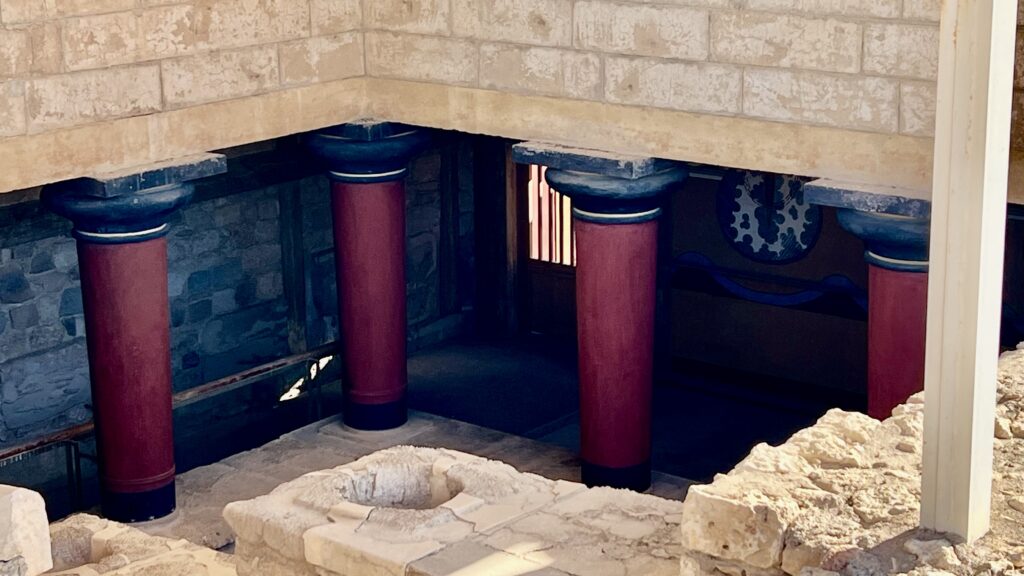
Palace of Knossos, Hall of Double Axes and Queen’s Megron – The Hall was so named by Evans because he found a double-axe sign engraved on the wall. He also thought the place was the residence of the King of Knossos. Near the Hall of Double Axes, is a smaller richly decorated hall that may have belonged to the Queen. Fragments of frescoes with dolphins and dancing ladies were found. The room has been restored and copies of wall paintings appear here.


Palace of Knossos, North Entrance and North Pillar Hall – An open air passage linked the Central Court with the North Entrance. Arthur Evans reconstructed the Bastion on the west end and placed a copy of a restored fresco of a bull here. The passage ends in a large hall with 10 square pillars which probably supported a large hall on the upper floor.


Palace of Knossos, The Magazines of the Giant Pithoi – The great Pithoi (Storage Jars) were found in a place named by Evans the ‘Magazines of the Giant Pithoi’. These magazines are one of the older parts of the Palace.

Palace of Knossos, Theatral Area, Royal Road – This area was called the Theater by Evans because it reminded him of theaters. A paved area with steps, it was probably used for ceremonies watched by standing viewers.


Heraklion Harbor – After exploring the Knossos palace, we took a taxi to the old town. Taxis are easily available as soon as you come out of the Palace.
You can spend a few hours walking around the Old Town harbor. Fishing boats line the shore, where a walkway runs along the waterfront. Across the road but fronting the harbor are the Venetian Arsenals, easily recognizable by the stone facade and huge archways. The ‘Arsenals’ are vaulted elongated structures and in their original form they were 50 meters long, 9 meters wide and 10 meters high and linked to each other through arched openings. The Venetians used them to manufacture, repair or keep their vessels.
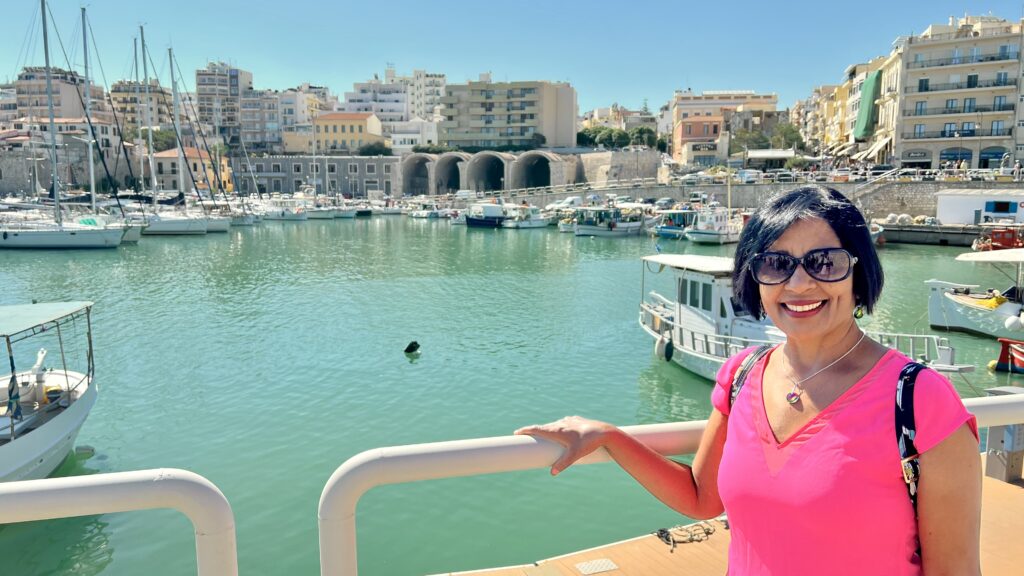

Koules Fortress – 4€/person entrance tkt – The 16th century fortress is the most notable monument along the harbor. Plan on spending 1-2 hours inside and outside the fort. We first walked around the fort taking in its thick walls, and then walking along/on top of the seawall that extends a couple of kilometers. Beyond the castle the seawall extends about a couple kilometers to a lighthouse. It’s a breakwater for the harbor, but also seemed to be a popular place for locals to jog or ride bikes.





The interior of the fort was recently renovated and has 26 rooms to explore. Grand wooden doors open into the room with displays that tells the story of the fort and milestones in the city’s history. There are also displays of ancient amphorae, Venetian cannons and others finds recovered from shipwrecks around Dia island in 1976.
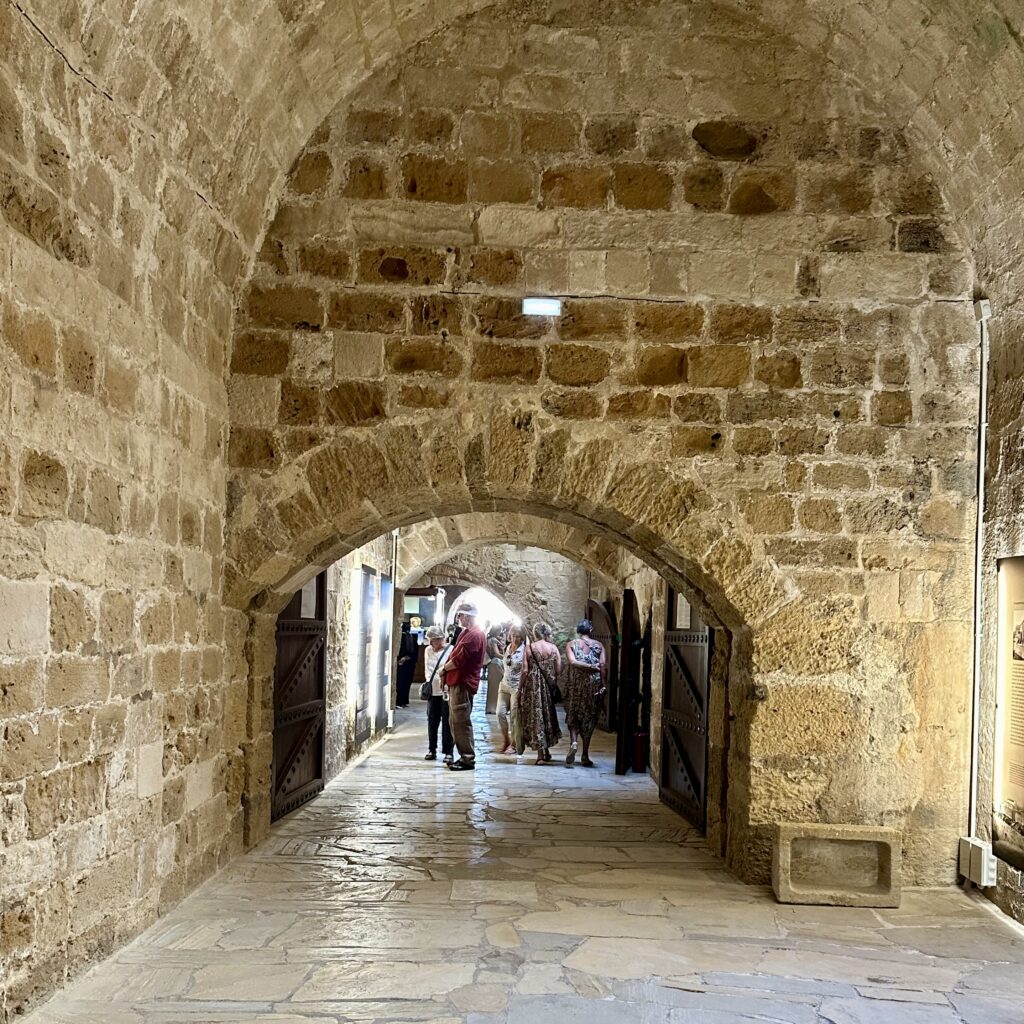
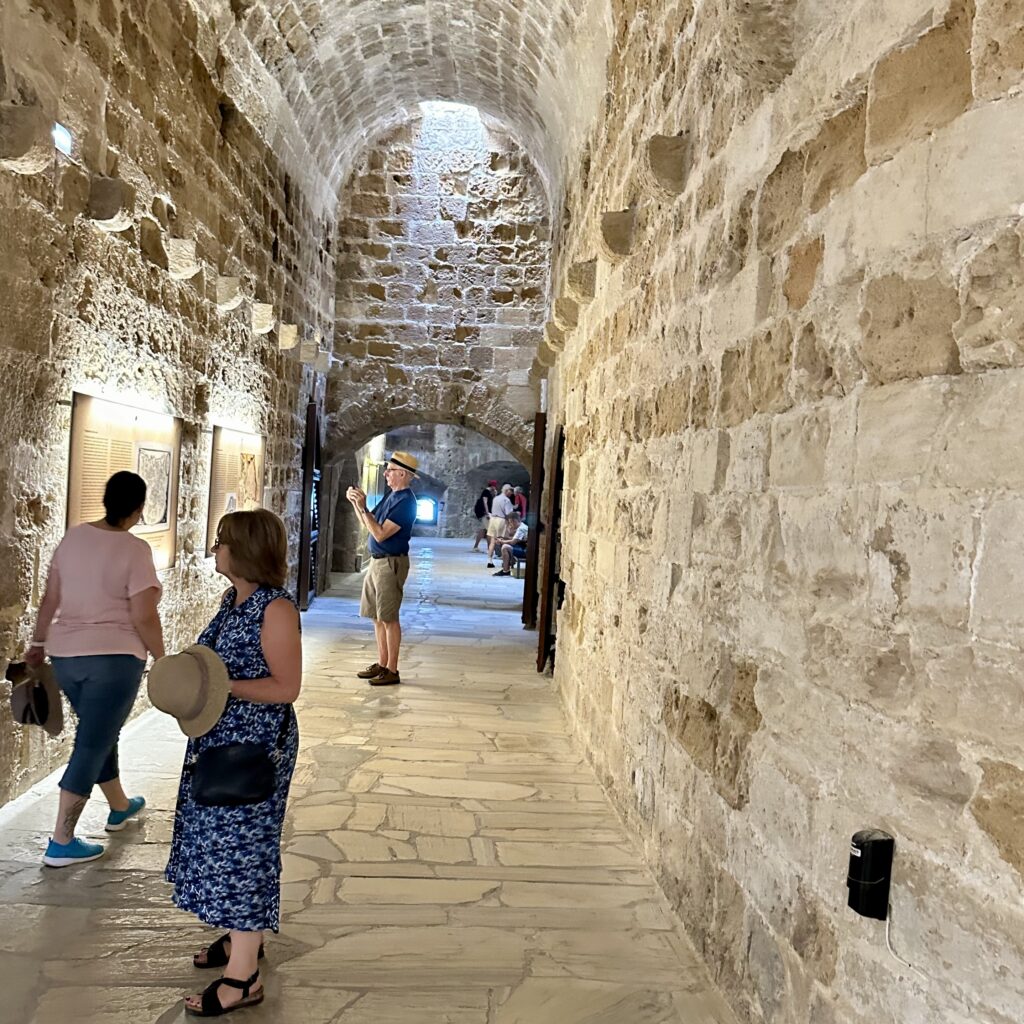



A stairway leads up to the roof of the fort. The rooftop has panoramic view of the city and sea.

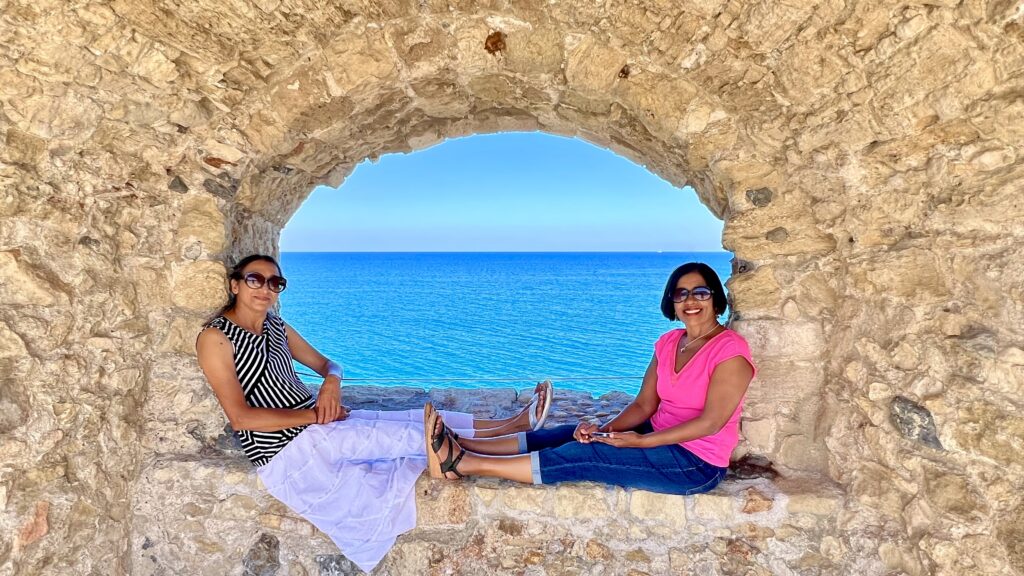
Heraklion Archaeological Museum – A 15 minute walk from the fortress took us to the museum which is one of the largest in Greece. It is the best museum in the world for Minoan art, as it contains by far the most important and complete collection of artefacts of the Minoan Civilization of Crete. The museum holds the great majority of the finds from the Minoan Palace at Knossos and and other Minoan sites in Crete.

Plan on spending at least an hour here even if you are not interested in history or seeing archaeological ruin findings.






I enjoyed the frescoes on the second floor which were unique and interesting.



Cathedral of St. Minas – One of the largest churches in Greece and the largest in Heraklion, this Greek Orthodox Cathedral serves as the seat of the Archbishop of Crete. Ιt is dedicated to Saint Minas the martyr and wonderworker (285-309 A.D.), who is the patron saint of Heraklion.
It was built from 1862 to 1895. The construction was interrupted during the Cretan Revolution of 1866 – 1869. The church has a cruciform architecture with a central dome. Its interior is as beautiful as its exterior.


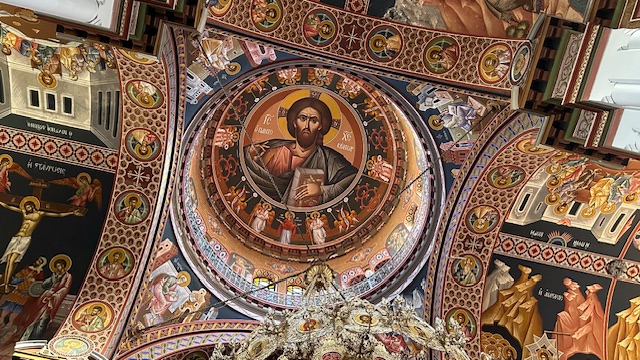
Agios Titos Church – Located in the heart of Heraklion the church was established in 961 AD by Byzantine Emperor Nicephorus Phokas and is dedicated to Saint Titos, who was the first bishop of the island. The church has undergone various changes throughout the years. During the Turkish Occupation period, it used to be a mosque, and then it underwent reconstruction after being destroyed by an earthquake in 1856. Its minaret was removed in 1920, and in 1925 it was converted to Christian church. The architectural style of the church consists of a mix of Byzantine, Venetian, and Ottoman influences.


Church of Paraskevi – Came across this small church as we were walking towards the center of town. Took a quick peek in.


Venetian walls surrounding Heraklion – The Old Town area of Heraklion is surrounded in parts by massive Venetian Walls which date back from the Middle Ages. The walls in most sections have been restored to their former glory and today are a popular place for locals and visitors to walk and explore. Access to walk on top of the walls is generally near a gate, and one of the gates of the Venetian wall was within 5 minutes walking distance from our Airbnb. A flight of stairs took us to the top of the wall and we took a relaxed evening walk.




Reason for picking Crete as one of the 2 islands :
- It is the largest of all Greek islands
- Many are of the opinion that this is the birthplace of European civilization.
- Since we were there only for 2 days, we were only able to cover all attractions in Heraklion (capitol city). If you have more time, you could consider visiting the breathtaking Samaria gorge and the other Minoan ruins – the Palace of Phaestos (62 km from Heraklion)